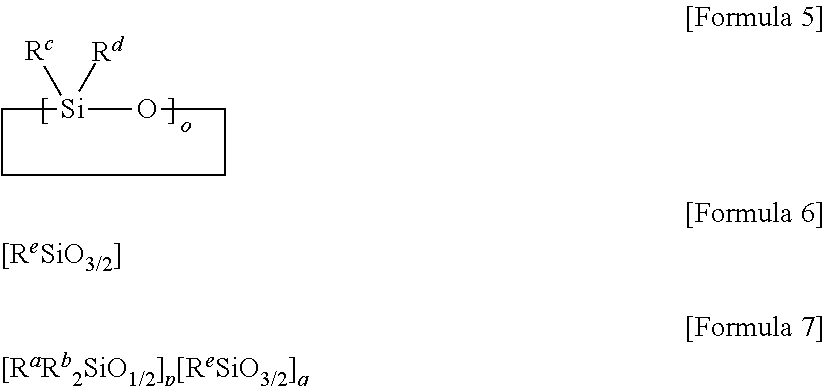Curable composition
a composition and composition technology, applied in the field of curable compositions, can solve the problems of low light resistance, low light resistance, and low light resistance of the encapsulant disclosed in the above references, and achieve excellent processibility and workability, excellent light extraction efficiency, and excellent light extraction efficiency.
- Summary
- Abstract
- Description
- Claims
- Application Information
AI Technical Summary
Benefits of technology
Problems solved by technology
Method used
Image
Examples
synthesis example 1
[0140]55.00 g of octamethylcyclotetrasiloxane, 120.4 g of octaphenylcyclotetrasiloxane, 9.6 g of tetramethyltetravinylcyclotetrasiloxane, 17.4 g of octaphenyl-polyhedral oligomeric silsesquioxane (octaphenyl-POSS) and 15.7 g of divinyltetramethyldisiloxane were mixed, and 0.6 mL of tetramethylammonium hydroxide (TMAH) was mixed into the mixture as a catalyst. Afterward, the mixture into which the catalyst was mixed was reacted at 115° C. for approximately 20 hours. A low molecular weight material was removed from the reaction product after reaction, thereby obtaining a transparent oil-type organopolysiloxane (A) represented by Formula A. The organopolysiloxane had a viscosity at 25° C. of 35,200 cP and a molecular weight of approximately 5,100. In addition, from the spectrum measured by 1H-NMR for the organopolysiloxane, a peak derived from an alkoxy group was not observed, and an acid value was measured at approximately 0.008.
[ViMe2SiO1 / 2]2[Me2SiO2 / 2]18[Ph2SiO2 / 2]15[ViMeSiO2 / 2]3[Ph...
synthesis example 2
[0141]An organopolysiloxane was synthesized by the method described in Synthesis Example 1, except that tetramethyltetravinylcyclotetrasiloxane was not used, and amounts at which octaphenyl-POSS and divinyltetramethyldisiloxane were mixed were changed to 8.7 g and 12.6 g, respectively. The organopolysiloxane was represented by Formula B, and present in transparent oil. The organopolysiloxane (B) had a viscosity at 25° C. of 19,600 cP and a molecular weight of approximately 5,000. In addition, from the spectrum measured by 1H-NMR for the organopolysiloxane, a peak derived from an alkoxy group was not observed, and an acid value was measured at approximately 0.009.
[ViMe2SiO1 / 2]2[Me2SiO2 / 2]20[Ph2SiO2 / 2]16[PhSiO3 / 2]2 [Formula B]
synthesis example 3
[0142]60.00 g of octamethylcyclotetrasiloxane, 106.96 g of octaphenylcyclotetrasiloxane, 17.44 g of octaphenyl-POSS and 12.56 g of divinyltetramethyldisiloxane were mixed, and 0.63 mL of tetramethylammonium hydroxide (TMAH) was mixed into the mixture as a catalyst. Afterward, the mixture into which the catalyst was mixed was reacted at 115° C. for approximately 20 hours, thereby obtaining a transparent oil-type polysiloxane represented by Formula C. The organopolysiloxane had a viscosity at 25° C. of 21,000 cP and a molecular weight of approximately 6,400. In addition, from the spectrum measured by 1H-NMR for the organopolysiloxane, a peak derived from an alkoxy group was not observed, and an acid value was measured at approximately 0.006 mg KOH / g.
[ViMe2SiO1 / 2]2[Me2SiO2 / 2]22[Ph2SiO2 / 2]15[PhSiO3 / 2]5 [Formula C]
PUM
| Property | Measurement | Unit |
|---|---|---|
| emission wavelength | aaaaa | aaaaa |
| molar ratio | aaaaa | aaaaa |
| molar ratio | aaaaa | aaaaa |
Abstract
Description
Claims
Application Information
 Login to View More
Login to View More - R&D
- Intellectual Property
- Life Sciences
- Materials
- Tech Scout
- Unparalleled Data Quality
- Higher Quality Content
- 60% Fewer Hallucinations
Browse by: Latest US Patents, China's latest patents, Technical Efficacy Thesaurus, Application Domain, Technology Topic, Popular Technical Reports.
© 2025 PatSnap. All rights reserved.Legal|Privacy policy|Modern Slavery Act Transparency Statement|Sitemap|About US| Contact US: help@patsnap.com



